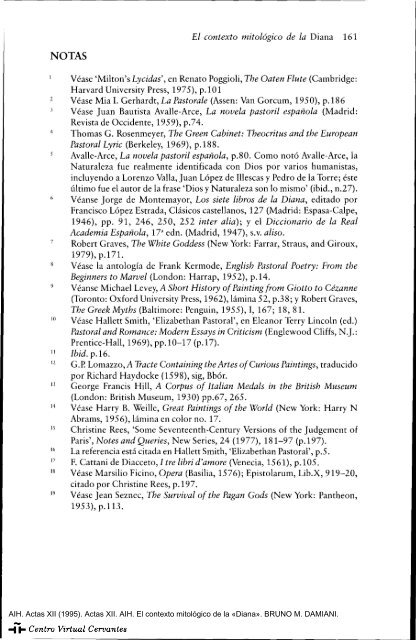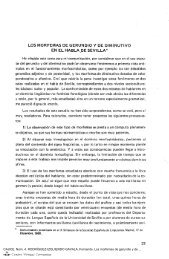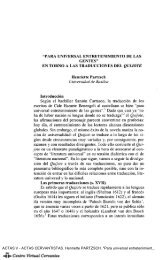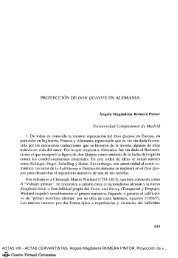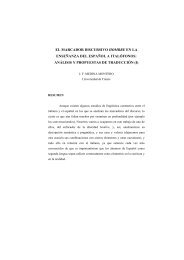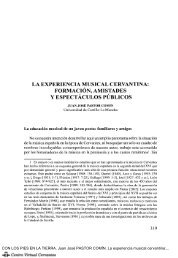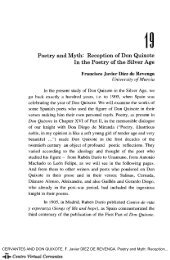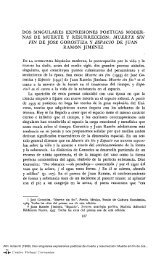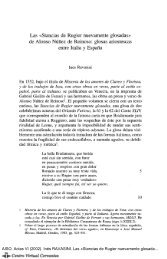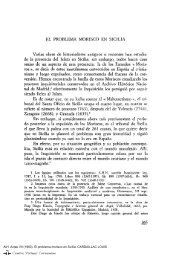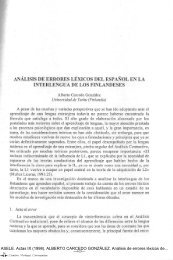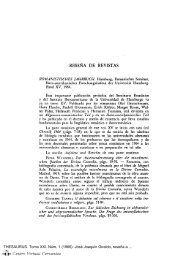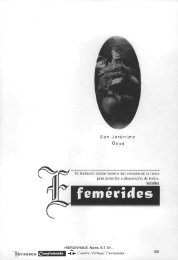El contexto mitológico de la Diana - Centro Virtual Cervantes
El contexto mitológico de la Diana - Centro Virtual Cervantes
El contexto mitológico de la Diana - Centro Virtual Cervantes
Create successful ePaper yourself
Turn your PDF publications into a flip-book with our unique Google optimized e-Paper software.
NOTAS<br />
<strong>El</strong> <strong>contexto</strong> <strong>mitológico</strong> <strong>de</strong> <strong>la</strong> <strong>Diana</strong> 161<br />
1<br />
2<br />
3<br />
4<br />
5<br />
6<br />
7<br />
8<br />
9<br />
10<br />
11<br />
12<br />
13<br />
14<br />
15<br />
16<br />
17<br />
18<br />
19<br />
Véase 'Milton's Lycidas', en Renato Poggioli, The Oaten Flute (Cambridge:<br />
Harvard University Press, 1975), p.101<br />
Véase Mia I. Gerhardt, La Pastorale (Assen: Van Gorcum, 1950), p.186<br />
Véase Juan Bautista Avalle-Arce, La nove<strong>la</strong> pastoril españo<strong>la</strong> (Madrid:<br />
Revista <strong>de</strong> Occi<strong>de</strong>nte, 1959), p.74.<br />
Thomas G. Rosenmeyer, The Green Cabinet: Theocritus and the European<br />
Pastoral Lyric (Berkeley, 1969), p.188.<br />
Avalle-Arce, La nove<strong>la</strong> pastoril españo<strong>la</strong>, p.80. Como notó Avalle-Arce, <strong>la</strong><br />
Naturaleza fue realmente i<strong>de</strong>ntificada con Dios por varios humanistas,<br />
incluyendo a Lorenzo Val<strong>la</strong>, Juan López <strong>de</strong> Illescas y Pedro <strong>de</strong> <strong>la</strong> Torre; éste<br />
último fue el autor <strong>de</strong> <strong>la</strong> frase 'Dios y Naturaleza son lo mismo' (ibid., n.27).<br />
Véanse Jorge <strong>de</strong> Montemayor, Los siete libros <strong>de</strong> <strong>la</strong> <strong>Diana</strong>, editado por<br />
Francisco López Estrada, Clásicos castel<strong>la</strong>nos, 127 (Madrid: Espasa-Calpe,<br />
1946), pp. 91, 246, 250, 252 ínter alia); y el Diccionario <strong>de</strong> <strong>la</strong> Real<br />
Aca<strong>de</strong>mia Españo<strong>la</strong>, 17 a edn. (Madrid, 1947), s.v. aliso.<br />
Robert Graves, The White God<strong>de</strong>ss (New York: Farrar, Straus, and Giroux,<br />
1979),p.l71.<br />
Véase <strong>la</strong> antología <strong>de</strong> Frank Kermo<strong>de</strong>, English Pastoral Poetry: From the<br />
Beginners to Marvel (London: Harrap, 1952), p.14.<br />
Véanse Michael Levey, A Short History ofPainting from Giotto to Cézanne<br />
(Toronto: Oxford University Press, 1962), lámina 52, p.38; y Robert Graves,<br />
The GreekMyths (Baltimore: Penguin, 1955), I, 167; 18, 81.<br />
Véase Hallett Smith, '<strong>El</strong>izabethan Pastoral', en <strong>El</strong>eanor Terry Lincoln (ed.)<br />
Pastoral and Romance: Mo<strong>de</strong>rn Essays in Criticism (Englewood Cliffs, N.J.:<br />
Prentice-Hall, 1969), pp.10-17 (p.17).<br />
Ibid.p.U.<br />
G.R Lomazzo, A Tráete Containing the Artes of Curious Paintings, traducido<br />
por Richard Haydocke (1598), sig, Bbór.<br />
George Francis Hill, A Corpus of ltalian Medals in the British Museum<br />
(London: British Museum, 1930) pp.67, 265.<br />
Véase Harry B. Weille, Great Paintings of the World (New York: Harry N<br />
Abrams, 1956), lámina en color no. 17.<br />
Christine Rees, 'Some Seventeenth-Century Versions of the Judgement of<br />
Paris', Notes and Queries, New Series, 24 (1977), 181-97 (p.197).<br />
La referencia está citada en Hallett Smith, '<strong>El</strong>izabethan Pastoral', p.5.<br />
F. Cattani <strong>de</strong> Diacceto, Itre libri d'amore (Venecia, 1561), p.105.<br />
Véase Marsilio Ficino, Opera (Basilia, 1576); Episto<strong>la</strong>rum, Lib.X, 919-20,<br />
citado por Christine Rees, p.197.<br />
Véase Jean Seznec, The Survival of the Pagan Gods (New York: Pantheon,<br />
1953),p.ll3.


